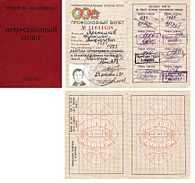Trade unions in the Soviet Union
| Part of a series on |
| Organized labour |
|---|
 |
|
Academic disciplines |

The slogan of the trade unions are a school of communism.
Trade unions in the Soviet Union, headed by the All-Union Central Council of Trade Unions, trace their history back to Russian Revolution of 1905. Many trade unions were shut down or restricted on the eve of World War I and during the War, but they revived after the February Revolution and their leaders were democratically elected during 1917.
Anarchists and some Bolshevik trade unionists hoped that unions would manage industry after the October Revolution. A strong factory committee movement had sprung up, from workers occupying workplaces or forcing their bosses into compliance with demands as the government would no longer protect them. However, as the Bolsheviks seized and consolidated power, this movement was ended by nationalizing industry. This only with the Russian Civil War and its policy of war communism the trade unions lost staff to government, Party, and military organs. Government economic organs, like the All-Russian Council of the Economy (VSNKh), increasingly took the primary role in directing industry, which lost many workers due to economic crisis. The Communist Party exerted increasing control over trade unions, which even many Communist trade union leaders resisted. By the end of the Civil War a dispute over the role of trade unions occurred within the ruling Communist Party. Leon Trotsky, Nikolay Krestinsky and some others insisted on militarization of trade unions and actually turning them into part of the government apparatus. The Workers' Opposition (Alexander Shlyapnikov, Alexandra Kollontai) demanded that trade unions manage the economy through an "All-Union Congress of Producers" and that workers comprise a majority of Communist Party members and leaders. There were several other factions. Eventually, all of them were defeated at the 10th Congress of the Russian Communist Party (Bolsheviks) by the so-called "Platform of the Ten" headed by Lenin, which called for trade unions to educate workers, under the control of the Communist Party. Since these times Vladimir Lenin's saying, "Trade Unions are a School of Communism" become an indisputable slogan.
A resolution entitled About the Party Unity dissolved and banned any factions within the Party under the pretext that intra-Party discussions distract from "solving actual practical problems". This resolution radically shifted the balance in the notion "democratic centralism" from "democratic" to "centralism" and enhanced the groundwork of Joseph Stalin's future dictatorship.
The newspaper Trud and the magazine, Soviet Trade Unions (Советские профсоюзы) were major media of the Soviet trade union system.
Like the Communist Party, the trade unions operated on the principle of democratic centralism, and they consisted of hierarchies of elected bodies from the central governing level down to the factory and local committees.
Soviet trade unions were, in fact, actually governmental organizations whose chief aim was not to represent workers but to further the goals of management, government, and the CPSU. As such, they were partners of management in attempting to promote labor discipline, worker morale, and productivity. Unions organized "socialist competitions" and awarded prizes for fulfilling quotas. They also distributed welfare benefits, operated cultural and sports facilities, issued passes to health and vacation centers, oversaw factory and local housing construction, provided catering services, and awarded bonuses and prepaid vacations.
Although unions in the Soviet Union primarily promoted production interests, they had some input regarding production plans, capital improvements in factories, local housing construction, and remuneration agreements with management. Unions also were empowered to protect workers against bureaucratic and managerial arbitrariness, to ensure that management adhered to collective agreements, and to protest unsafe working conditions. However, strikes were illegal.
Late Soviet Union
The trade union system in the late Soviet Union consisted of thirty unions organized by occupational branch. Including about 732,000 locals and 135 million members in 1984, unions encompassed almost all Soviet employees with the exception of some 4 to 5 million kolkhozniks. Enterprises employing twenty-five or more people had locals, and membership was compulsory. Dues were about 1% of a person's salary. The All-Union Central Council of Trade Unions (Всесоюзный Центральный Совет Профессиональных Союзов, ВЦСПС) served as an umbrella organization for the thirty branch unions and was by far the largest public organization in the Soviet Union.
Union membership influenced union operations only at the local level, where an average of 60% of a union's central committee members were rank-and-file workers.
After the Polish trade union movement, Solidarity, had achieved some success in Poland Soviet trade unions became more vocal in protecting workers' interests.
References
 This article incorporates public domain material from websites or documents of the Library of Congress Country Studies. - Soviet Union
This article incorporates public domain material from websites or documents of the Library of Congress Country Studies. - Soviet Union
Bibliography
- Ashwin, Sarah and Simon Clarke. Russian Trade Unions and Industrial Relations in Transition. NY: Palgrave Macmillan, 2003.
- Bonnell, Victoria. Roots of Rebellion: Workers' Politics and Organizations in St. Petersburg and Moscow, 1900-1914. Berkeley and Los Angeles: University of California Press, 1983.
- Davis, Sue. Trade Unions in Russia and Ukraine, 1985-1995. NY: Palgrave Macmillan, 2002.
- Ruble, Blair. Soviet Trade Unions: Their Development in the 1970s. Cambridge: Cambridge University Press, 1981.
- Sorenson, Jay. The Life and Death of Soviet Trade Unionism, 1917-1928. New York, 1969.
External links
- (Russian) Trade Unions in the USSR
See also
- Creative unions in the USSR, analogs of trade unions for creative workers (writers, artists, etc.)
- Red International of Trade Unions